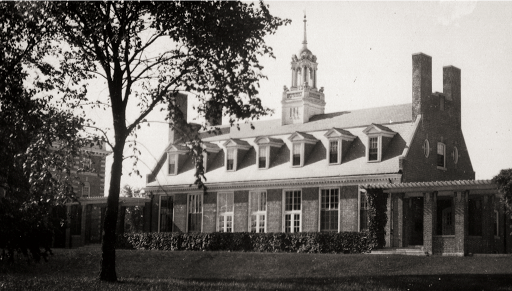In our previous issue, I analyzed the history of Wheaton College’s very own Balfour-Hood Center. Conceptualized as part of Ralph Adams Cram’s 1897 campus design plan for Wheaton College, Balfour-Hood was only one of several buildings proposed at that time. Emerson Dining Hall, and Larcom hall next to it, were also part of this “new” Wheaton campus.
Emerson Dining Hall is a favorite on campus. Described by tour guides as the “Harry Potter Dining Hall,” Emerson is a bustling hub for activity with an old-fashioned look. Emerson Dining Hall was designed by Ripley & Russel and built in 1908, named after Wheaton College’s former trustee and treasurer, Reverend Alfred Emerson.
When Emerson was built, it stood as a landmark on the Wheaton College campus. Not so much for its exterior, though — the interior made it remarkable. Paneled with oak wainscoting, boasting four large fireplaces, serving rooms fit for kings, and new technologies in the kitchen, Emerson was (and still is) stunning. According to Collegehistory.com, Emerson was named by Good Housekeeping magazine as one of the United States’ most beautiful dining halls for its time.
Collegehistory.com also tells of Emerson’s luxuries like the warming ovens, tea, coffee, and chocolate dispensers that could be found in the old serving rooms. The cereals eaten at breakfast used to be handmade at Emerson, cooked in “great cauldrons” in the kitchen. Also in the kitchen sat an industrial dishwasher, called “a modern live-steam machine.” While there are no records of what this “modern machine” looked like, the dishwasher in the current kitchen is still pretty steamy. With the looks of an airport security setup, the dishwasher is a long hunk of metal that uses a conveyor belt to drag dirty dishes through the mini “car-wash.” Although the plates are left hot to touch, they leave this industrial machine thoroughly cleaned.
Ever wonder why the tables by the windows in Emerson are separated by the large wooden pillars and a stone half wall? Well there’s history to that too. In the original design for Emerson Dining Hall, this part of the building wasn’t part of the interior. It was a porch on the outside that acted as an important patio space for enjoying the fresh air while gazing out at the Dimple. Since the Dimple never ended up turning into the proposed reflecting pond for Emerson, some plays were performed in it, and spectators could watch from the patio.
Eventually, as enrollment to Wheaton College increased, this terrace was covered with a roof and the extension to the dining hall was complete. However, the walls still stand at half their height to mimic this outdoor exclusion from the dining hall, and give this part of the interior an outdoor appeal.
Emerson Dining Hall is definitely a favorite among buildings on the Wheaton College campus. Whether students are enjoying the fresh pastries and coffees from the Starbucks, holding club meetings on the faux patio, or studying with friends, Emerson is a step up in luxury compared to lower campus’ Chase Dining Hall. It is a great place to enjoy the hot meals available with meal swipes or special cuisines available for Lyons Bucks. A freshly tossed salad bar is also a favorite and a wide array of sodas and snacks are available for purchase, including Ben & Jerry’s ice cream.
Sought after for its large interior and back rooms, Emerson also hosts the Spring semester Club and Activities Fair, as well as many other student-run events, like Dimple Divers shows, school dances, self-care nights, sex trivia games, and much more, including the infamous MAP Day held each semester. Emerson is a great hub for faculty as well as students. Separate faculty dining halls were included in the original design, along with faculty events, like free massages and spa days for the staff.
While Emerson is a clear favorite today, when it was first built in 1908, it was quite controversial. As part of Ralph Adams Cram’s campus design, Emerson was built to look into the Dimple and into Wheaton’s campus. However, the town of Norton, Massachusetts didn’t find this so appealing. They saw the act of facing the Dimple as an act of separation from the town — as if Emerson dining hall was showing the town of Norton that Wheaton was turning away from them and in on themselves to create their own community. Although the town protested the construction of Emerson, Mrs. Wheaton, founder of Wheaton College, explained that the creation of an exclusive community was exactly the point of a college campus.
All images from Collegehistory.com
